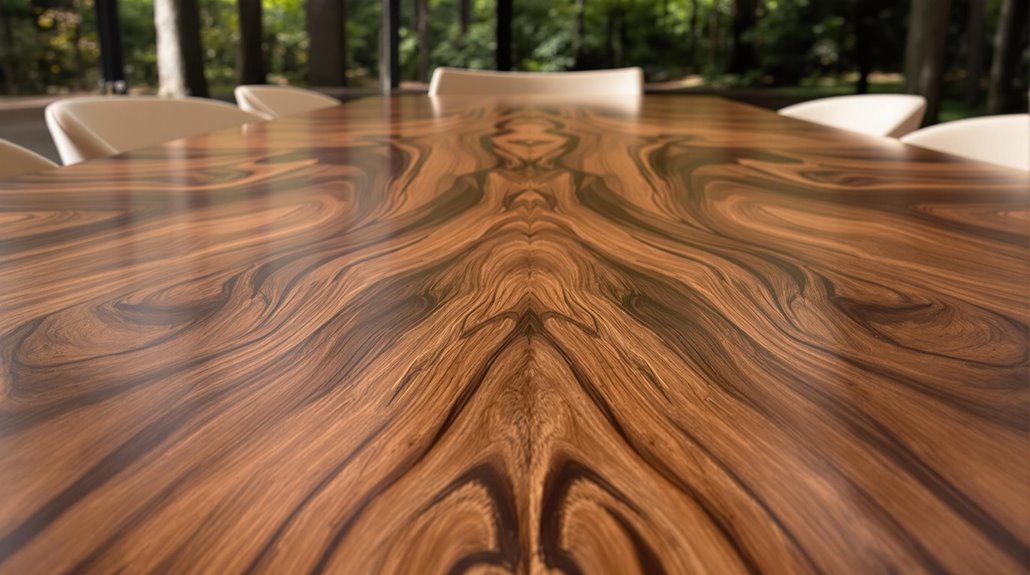The most desirable wood for furniture typically includes hardwoods such as mahogany, oak, and walnut, prized for their durability, strength, and aesthetic appeal. Mahogany is favored for its elegant look and resistance to wear, making it ideal for high-end pieces. Oak offers extraordinary strength and is adaptable to various design styles. Walnut, known for its luxury and intricate grain patterns, also boasts significant durability. Alternatives like eucalyptus present sustainable options with considerable hardness, while cedar excels in outdoor applications due to its natural decay resistance. Each type has its unique advantages, which can be further explored for informed decision-making.
Overview of Desirable Woods
When selecting woods for furniture, the choice between hardwoods and softwoods greatly influences both the aesthetic and functional qualities of the final piece. Hardwoods, such as maple, oak, cherry, and walnut, are known for their durability and resistance to wear. For instance, maple offers moisture resistance and flexibility, making it suitable for high-use items. In contrast, softwoods like pine and cedar are lighter and more affordable, often used for rustic or casual designs. While pine's versatility makes it popular, cedar's natural resistance to moisture enhances its suitability for outdoor applications. Ultimately, the desired characteristics, including durability, appearance, and cost, guide the selection of wood, whether opting for the sturdiness of hardwoods or the accessibility of softwoods.
Mahogany: Elegance and Durability
Mahogany stands out as a premier choice in the domain of fine furniture, celebrated for its elegant appearance and remarkable durability. Its rich, reddish-brown hue deepens beautifully with age, while the straight grain can exhibit unique figures such as waves or curls. The fine texture of mahogany allows for an exceptionally smooth finish, often showcasing a fascinating cat's eye effect that enhances its visual appeal. This hardwood is not only visually striking but also possesses significant durability; it resists wear and tear, moisture, and termites, ensuring longevity. With a density that balances workability and strength, mahogany is ideal for high-end furniture, cabinetry, and intricate carvings, making it a prized material in the furniture-making industry.
Maple: Affordability and Versatility
Maple wood stands out as a cost-effective hardwood choice, appealing to budget-conscious consumers without compromising on quality. Its versatility allows for a wide range of applications, from sleek modern furniture to traditional designs, making it suitable for various aesthetic preferences. Additionally, maple is easy to work with, accommodating different finishing techniques and enhancing its adaptability across multiple furniture projects.
Cost-Effective Hardwood Choice
As a cost-effective hardwood choice, maple offers both affordability and versatility, making it an ideal option for furniture makers and consumers alike. Maple is one of the less expensive hardwoods, comparable to oak, and is more affordable than cherry and walnut due to its quicker growth and higher availability. Its widespread availability, particularly in Canada, contributes to its cost-effectiveness without compromising quality, making it suitable for high-quality bedroom sets. In addition, maple wood can be easily stained to resemble other wood types and provides a smooth, clean appearance with minimal grain. Its durability, with a Janka hardness rating similar to cherry wood, guarantees that maple furniture remains resistant to scratches and dents, making it a practical choice for various applications.
Wide Range Applications
How can one truly appreciate the versatility of maple wood in furniture design? Maple's exceptional durability and strength make it an ideal choice for various applications, ranging from dining tables and chairs to children's bedroom furniture. Its dense, tight grain structure guarantees resistance to scratches and dents, allowing it to perform well in high-traffic areas. Additionally, maple can be easily adapted to suit diverse design preferences, enabling craftsmen to create everything from modern minimalist pieces to richly ornamented traditional furniture. This adaptability extends to aesthetic treatments as well, as maple can be stained to highlight its natural beauty or mimic other wood types. Consequently, maple wood stands out as a versatile and reliable option for custom furniture designs.
Easy to Work With
Craftsmen and furniture makers appreciate maple wood for its exceptional ease of workability, which contributes to its popularity in the industry. Maple possesses excellent turning properties, allowing for intricate designs, while its ability to hold nails securely guarantees durability in construction. This wood polishes well, enhancing its natural beauty and making it suitable for various finishes. Additionally, maple glues moderately well, facilitating reliable joints and assemblies. Its quick drying time minimizes the risk of warping or cracking. Beyond workability, maple is also an affordable option due to its wide availability in North America and faster growth rate, making it an attractive choice for furniture that does not compromise on quality or aesthetics.
Oak: Strength and Classic Appeal
Oak is renowned for its exceptional durability and longevity, making it a preferred choice for furniture that endures daily use in high-traffic areas. Its aesthetic versatility allows it to seamlessly integrate into various interior styles, from traditional to contemporary, while maintaining a classic appeal that enhances the overall decor. Additionally, oak's cost-effectiveness, in comparison to other hardwoods, positions it as an attractive option for those seeking quality without compromising their budget.
Durability and Longevity
While many woods offer aesthetic appeal, few can match the durability and longevity of oak, which is renowned for its strength and timeless charm. Oak's high density contributes to its exceptional sturdiness, making it resilient against scratches, dents, and other damages. With a high Janka hardness rating, oak withstands the rigors of daily use, making it ideal for families and high-traffic areas. Its natural resistance to moisture and insect infestation guarantees oak furniture can endure for decades, or even generations, without significant wear. Additionally, oak's flexibility allows it to absorb shock effectively, enhancing its durability. This robust wood is not only practical but also a sustainable choice, providing both longevity and structural integrity for diverse furniture designs.
Aesthetic Versatility
Renowned for its timeless elegance, oak furniture seamlessly marries strength with aesthetic versatility, making it a favored choice among designers and homeowners alike. Its intricate carvings and gracefully curved edges highlight a commitment to craftsmanship, while the natural grain patterns and warm tones enhance any interior. Oak's adaptability allows it to complement various styles, from traditional and rustic to modern and minimalist. This versatility enables it to create diverse ambiances, whether in formal dining rooms or cozy living spaces. Additionally, oak furniture retains its visual appeal over time, integrating well with eclectic designs and grounding contrasting elements. Its ability to evoke warmth and sophistication makes oak an ideal choice for a broad range of design preferences.
Cost-Effectiveness
The aesthetic appeal of oak furniture is matched by its cost-effectiveness, making it a wise investment for both residential and commercial spaces. Although oak typically has a higher initial cost due to its long growth cycle and increasing demand, its long-term advantages often justify this expense. Entry-level oak bed frames start around £500, while high-end designs can reach several thousand pounds. However, oak's superior longevity means it can last for decades, reducing the need for frequent replacements. Its durability against scratches and wear guarantees that it maintains its structural integrity over time. Additionally, well-maintained oak pieces can retain significant resale value, particularly those sourced from managed forests, aligning with sustainable practices and enhancing their overall appeal.
Walnut: Luxury and Resilience
Walnut stands as a symbol of luxury and resilience in the world of furniture making. Registering 1010 lbf on the Janka scale, walnut outperforms notable woods like teak and mahogany in hardness and durability. Its high density provides resistance to scratches, indentations, and water, making it an ideal choice for furniture that withstands daily use. Aesthetically, walnut boasts a deep brown hue with unique grain patterns, enhancing the elegance of any space. Its versatility allows for intricate shaping and finishing options, catering to a wide range of furniture styles. Additionally, walnut's natural oils afford resistance to water and termites, ensuring longevity when properly cared for, solidifying its status as a premium material in the furniture industry.
Eucalyptus: Sustainability and Hardness
Eucalyptus wood has emerged as a highly desirable choice in furniture making, primarily due to its impressive sustainability and hardness. This fast-growing tree species offers a renewable resource, allowing for frequent harvesting without detriment to forest ecosystems. Its cultivation contributes to forest preservation and minimizes the environmental impact associated with traditional hardwoods. Regarding hardness, eucalyptus boasts a Janka hardness rating between 1,125 and 1,420 pounds, positioning it as a highly durable material, comparable to white oak and mahogany. Its density, averaging 53 pounds per cubic foot, enhances its strength and stiffness, making it suitable for various furniture applications. Additionally, the wood exhibits excellent resistance to wear, pests, and moisture, ensuring longevity with proper care.
Cedar: Outdoor Suitability
Cedar wood stands out as an exceptional option for outdoor furniture, offering a unique combination of durability and aesthetic appeal. Its inherent natural oils provide resistance to decay, rot, and insect infestation, making it particularly suitable for various climates, including humid and tropical conditions. Cedar absorbs moisture without cracking, thereby maintaining its structural integrity. Additionally, its lightweight nature allows for easy rearrangement, while still being strong enough to withstand strong winds. Maintenance is minimal; periodic cleaning and sealing are typically sufficient, and the wood does not require painting or staining. Moreover, cedar is an affordable choice compared to hardwoods, offering a reasonable cost for high-quality outdoor furniture that can last for years with proper care.
Aesthetic Considerations of Woods
While the choice of wood greatly influences the overall aesthetic of furniture, it is essential to contemplate both the natural beauty and the versatility that various wood types offer. Wood inherently adds organic warmth, showcasing unique grain patterns and a variety of color tones that enhance any space. Species such as oak and walnut provide distinctive textures and striking visuals, contributing to depth and character. The adaptability of wood allows for a wide range of designs, from minimalist to ornate styles, ensuring it fits into any decor. Additionally, the timeless appeal of wooden furniture, coupled with its historical significance and durability, makes it a lasting choice, maintaining relevance across changing design trends.

